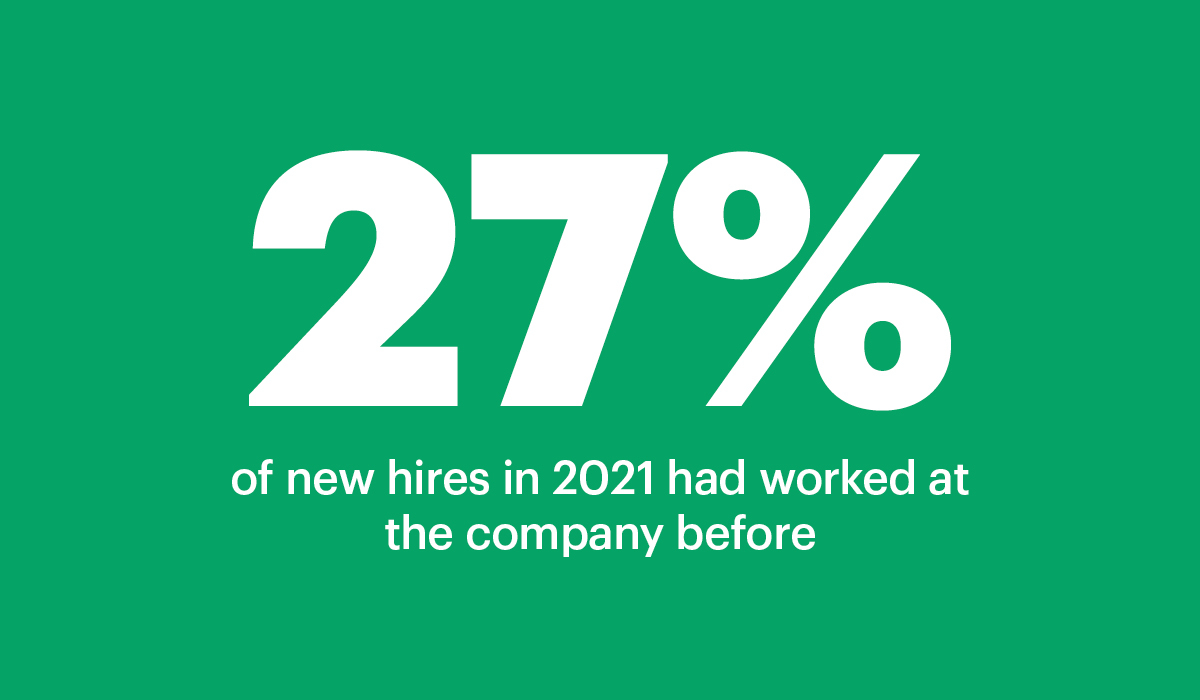
The
resignation wave caused talent shortages and internal upheaval in organizations for the past two years. In response, many organizations had to replace lost talent by hiring external talent fast and at volume to enable post-pandemic
recovery and growth. However, according to
several industry reports, many employees who switched jobs are now seeming to reconsider their choices—they either look for new jobs shortly after
joining an organization, or are rehired by their previous employer, and become a rehire, a so-called “
boomerang employee.”
Considered a
taboo in the past, rehiring employees is a trend now curiously eyed by researchers, as both organizations and employees are realizing benefits and new opportunities by re-entering a
known work relationship.
At Visier, we were curious if we would spot this trend in our own community database of 15 million anonymized employee records—and we did.
The rehire trend is real
Studying data from the Visier community database showed that, indeed, the “boomerang employee” trend was real. The data, along with several interviews with these types of employees, revealed both the numbers behind the trend, as well as some of the reasons for it.
Our data scientists’ analyses of our dataset covering the past three-and-a-half years show that the rehire rate has been between 27% and 29% (annualized). This means that in 2021, for example, 27% of all external hires had a resignation event at the same company within the past three years. (The numbers have crept up over the 2021 rate already by one percent in 2022 so far.)

The demographic profile of boomerang employees were surprising: We found that rehired employees in our sample also left—and in some cases returned to—a manager-level position, performed at medium- to high-levels of performance in their jobs at time of resignation, and were spread out across all ages 30 years and up.
Retention and rehire strategies: 3 metrics to watch
What does this all mean for organizations? How can they determine if and when a rehire strategy may make sense? Based on the research findings, keep an eye on these three metrics when hiring, rehiring, and retaining new (or not-so-new) employees.
1. Resignation rates
Voluntary attrition has received a lot of attention in recent years, and continues to be a metric to watch. The ability to drill down into the details of resignation rates to learn about where, who, and why is leaving—and perhaps returning—has become table stakes for data-minded companies. Combined with resignation rates, a thorough understanding of the drivers of resignations—compa-ratios, promotion rates, or engagement data—is helpful to monitor both attrition and rehire rates when it comes to understanding what really drives people out and perhaps, what brings them back.
2. Employee listening
During the pandemic, organizations focused on continuous listening to take the pulse of employee experience including the level of perceived engagement, inclusion, and opportunities.
Hybrid and remote work models made it challenging for managers to stay in touch with team members.
Engagement, experience, pulse and “listening” data integrated with other talent and business metrics are a key metric that are table stakes for organizations focusing on employee retention.
3. Compensation
Recent talent shortages and hiring trends caused compensation budgets in some organizations to go out the window as job switchers earned higher median wage growth than those who stayed. Our data shows that boomerang employees benefited from a pay bump by 20%-25% on average in recent years—a curious fact that may be telling about the company’s retention and compensation strategies. Of course, a blanket pay raise for all is neither reasonable and might not even be necessary. Knowing which area in the business is more sensitive to pay can be a better targeted compensation strategy.
About the authors:
Andrea Derler, Ph.D.: Dr. Andrea Derler is the Principal, Research and Customer Value at Visier, an organizational researcher, and previously, a human capital analyst. She has a background in management research, human science, and human capital consulting. At Visier, Andrea leads research efforts and helps produce databased, practice-oriented, and actionable insights for business and HR leaders.
Carlina Kim: After completing her Master of Data Science at UBC, Carlina joined Visier as a Data Science Intern. She is currently a part of the Publication & Research focus of the Data Science & Engineering team and her main responsibilities involve running research projects end-to-end including developing analysis scripts, running our research pipeline and creating visualizations and statistical analyses for Visier’s reports.
Manda Winlaw Ph.D.: Dr. Manda Winlaw is a Senior Data Scientist at Visier, the leader in people analytics. She has worked as a data scientist in a number of different fields and strongly believes in using data to drive better decisions for all people. She holds a PhD in Applied Mathematics and Masters in both Economics and Computational Mathematics.
About the author: Visier Team
People-centered ideas and insights by the editorial team at Visier.
SOURCE
Is Rehiring the New Hiring Strategy? Boomerang Employees Say Yes | Visier Inc.

